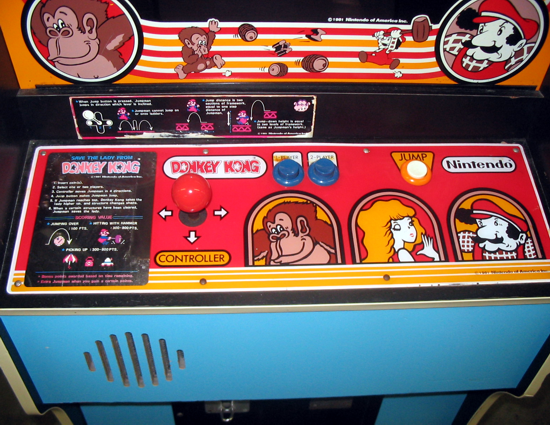 |
| Donkey Kong logo 1981 |
Original name: "Monkey Kong"
Name: "Donkey Kong"
Category: Video games
Subcategory: Arcade
Genres: Jump and Run, Platform
Inventor: Shigeru Miyamoto
Developer - Publisher: Nintendo Co., Ltd. - Kyoto, Japan
Released: July 9, 1981 (Japan) - Later 1981 (North America)
Platform: Arcade
First price: 1 play 1 coin - 25 cents
 |
| Shigeru Miyamoto (Sonobe, Nov. 16, 1952) video game developer and creator of the arcade Donkey Kong |
Cast of characters:
--- Mario (original name Jumpman). He will go on to become one of the biggest video game stars of all time. He is a carpenter (instead a plumber as in subsequent versions).
--- Pauline (original name Lady). Mario's girlfriend and damsel in distress. She is stuck at the top of each screen awaiting rescue.
--- Donkey Kong (original name Monkey Kong). He has kidnapped Pauline and carried her up to the top of the construction site that Mario is working at.
--- Mario (original name Jumpman). He will go on to become one of the biggest video game stars of all time. He is a carpenter (instead a plumber as in subsequent versions).
--- Pauline (original name Lady). Mario's girlfriend and damsel in distress. She is stuck at the top of each screen awaiting rescue.
--- Donkey Kong (original name Monkey Kong). He has kidnapped Pauline and carried her up to the top of the construction site that Mario is working at.
Music by: Hirokazu Tanaka
Features: In Donkey Kong, Mario must rescue a damsel in distress named Pauline from a giant ape named Donkey Kong (the hero and ape later became two of Nintendo's most popular and recognizable characters). In addition to presenting the goal of saving Pauline, the game also gives the player a score. Points are awarded for the following: finishing each stage; leaping over obstacles; destroying objects with a hammer power-up; collecting items such as hats, parasols, and purses that Pauline has dropped on her way to the top of the building. The player typically receives three lives with a bonus awarded for the first 7,000 points, although this can be modified via the game's built in DIP switches. The game is divided into four different single-screen stages. Each represents 25 meters of the structure Donkey Kong has climbed, one stage being 25 meters higher than the previous. The final stage occurs at 100 meters. Stage one involves Mario scaling a construction site made of crooked girders and ladders while jumping over or hammering barrels and oil barrels tossed by Donkey Kong. Stage two involves climbing a five-story structure of conveyor belts, each of which transports cement pans. The third stage involves the player riding elevators while avoiding bouncing springs. The final stage involves Mario removing eight rivets which support Donkey Kong. Removing the final rivet causes Donkey Kong to fall and the hero to be reunited with Pauline. These four stages combine to form a level. Upon completion of the fourth stage, the level then increments, and the game repeats the stages with progressive difficulty. For example, Donkey Kong begins to hurl barrels faster and sometimes diagonally, and fireballs get speedier. The victory music alternates between levels 1 and 2. The 22nd level is colloquially known as the kill screen, due to an error in the game's programming that kills Mario after a few seconds, effectively ending the game. The game uses graphics and animation as vehicles of characterization. Donkey Kong smirks upon Mario's demise. Pauline has a pink dress and long hair, and a speech balloon crying "HELP!" appears frequently beside her. The carpenter Mario, depicted in red overalls and cap, is an everyman character, a type common in Japan. Graphical limitations and the low pixel resolution of the small sprites prompted his design: drawing a mouth is infeasible, so the character was given a mustache; the programmers could not animate hair, so he got a cap; and to make his arm movements visible, he needed colored overalls. The artwork used for the cabinets and promotional materials make these cartoon-like character designs even more explicit.
Interesting facts: Donkey Kong is one of the earliest examples of the platform game genre. With its four unique stages, Donkey Kong was the most complex arcade game at the time of its release. Donkey Kong is also the first example of a complete narrative told in video game form, and like 1980's Pac-Man, it employs cutscenes to advance its plot.
Slogan (game intro): «How high can you get?», originally «How high can you try?»
Property: Nintendo Co., Ltd.
Producer website: http://www.nintendo.com
 |
| Donkey Kong, some of the original hand drawn concept designs for the game |
 |
| Donkey Kong, screenshot of the play area |
 |
 |
Donkey Kong "cocktail table" cabinet |
 |
 |
Donkey Kong upright cabinet released first in red, then light blue |
| Donkey Kong, first level gameplay |
 |
 |
Donkey Kong original flyer front-back (1981) |
 |
 |
Donkey Kong American flyer front-back (1981) |
 |
 |
Donkey Kong cartridge for Atari home computers, package front-back (1983) |
 |
A poster by Nintendo celebrating Donkey Kong's 30th anniversary (2011) |



